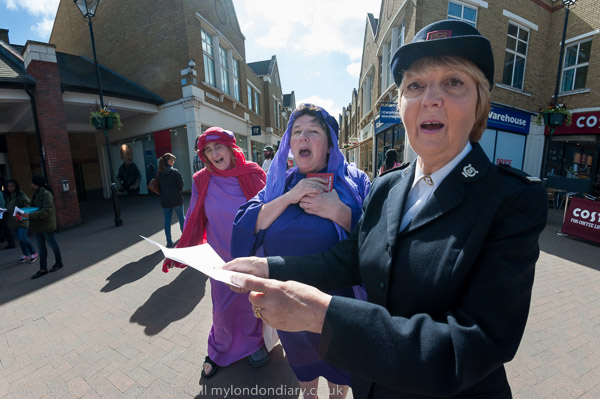
Good Friday is a day when Christians in different places around the country engage in processions of witness. I’ve often photographed these in Westminster and a few other places in central London, where there are some rather fancier churches and some better known people taking part.
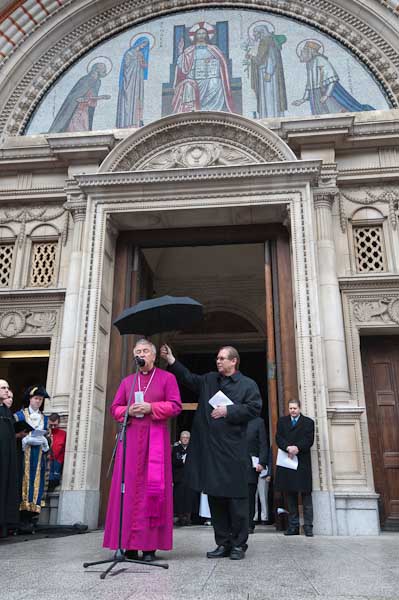
2010 I photographed my third Archbishop of Westminster, the Most Reverend Vincent Nicholls, now Cardinal Vincent Nichols, but there were so many photographers present, and I felt their presence was considerably too intrusive. Of course I tried to behave with appropriate reverence, but others did not, and I wasn’t too keen to go and repeat the experience another year.
Of course, Westminster is not the only game in town, and I’ve also photographed processions in Waterloo, Islington and Archway, as well as the Butterworth Charity at St Bartholemew the Great in Smithfield, and possibly elsewhere. But in the last few years I’ve stayed closer to home and photographed the procession in the town where I live, Staines.
There is nothing very special about Staines. There were settlements in the area thousands of years before the Romans came, and while they built a town here where their road to the south-west went over the Thames, all that was soon gone (though archaeologists made many interesting discoveries in the last half of the last century where they managed to get on to sites before the concrete was poured.) When I was young you could still see cattle being driven down one of its major roads, but it had one major claim to fame. Around the world people walked on linoleum made here – and the air was heavy with the stench of linseed oil. Vinyl put paid to lino; the works is now a shopping centre, and the air is now thick with the pollution and fumes from the M25 and Heathrow instead.
And it was to that shopping centre that the Staines Procession of Witness made its way from the Methodist Church close to the River Thames (spitting distance from where the Romans probably crossed it) to the former lino, now the ‘Two Rivers Shopping Centre’. Neither of the rivers is the Thames; the lino came here in the 1860s to a mill on the River Colne, and around the site’s western edge runs the Wyradisbury River, one of several distributaries of the Colne. A third stream, Sweep’s Ditch. ran from the Colne along the southern edge of the site, but was blocked by redevelopment in the 1970s and now begins half a mile to the south, with water pumped specially from the Thames.
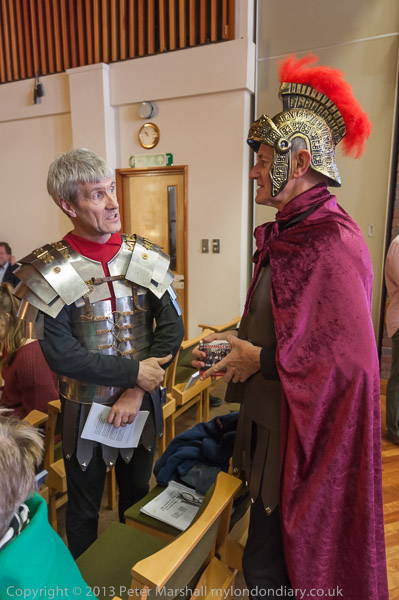
But it did seem appropriate because of the town’s history that there should be a group of four Roman soldiers taking part in the procession, although their presence was rather connected with the history of Christianity and the Holy Land than Staines past. It was Staines one day on that they were there to publicise, when Christians in the town were staging for the first time an open-air performance of the Staines Passion, based loosely on the Passion of Jesus as performed on by the players from Wintershall in Trafalgar Square which I photographed it in 2010.
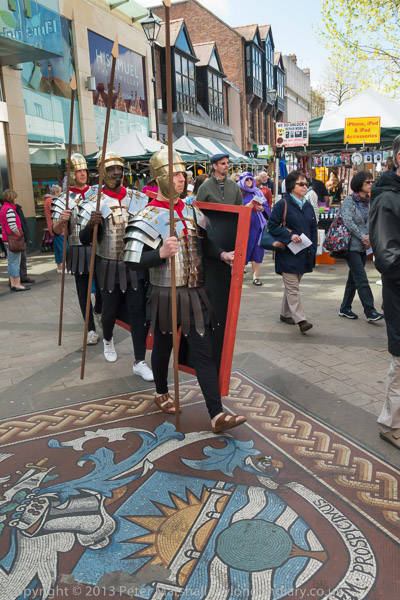
Staines used to be one of the major towns of Middlesex, but is now a rather minor partner in Spelthorne, whose true blue councillors don’t much care for the downmarket area of the borough, and whose council officers would like to cover it most of it with high-rise offices (and but for the crash might have succeeded.) It’s also since 1965 a part of Surrey, rather to the disgust of many Staines residents who thus failed to get the advantages of being a part of Greater London – like regular buses. More recently they played a nasty trick on the town, changing its official name to ‘Staines Upon Thames’, though I’ve never heard any real Staines resident use the new name except in mockery. It appears to have happened because of a drunken bet in the Conservative Club and was achieved by a pathetically bent consultation. Apparently some Conservatives thought that Ali G had given Staines a bad name – but that just shows they have no sense of humour. The local football club had adopted him as their mascot, with some die-hard fans copying his mode of dress for matches.
But a few years ago, Spelthorne did try and spend a little money on Staines, producing a disastrous riverside area and an ‘Art Trail’ with some artworks of very varied quality. A couple of these were on the route of the procession, and I tried hard to feature them in my pictures, though not too successfully. The mosaic is one of the better pieces, but the soldiers marched around the wrong side of it for my picture, showing the rather plain backs of their shields.
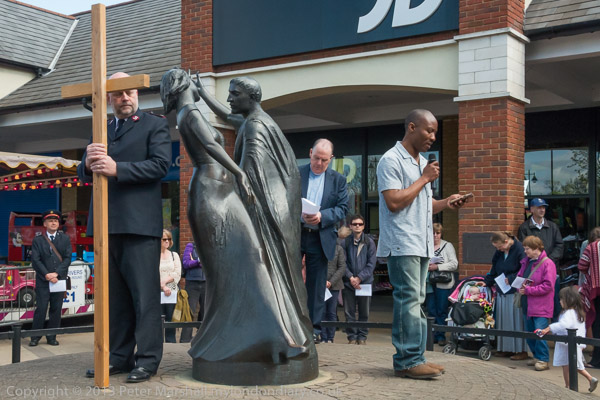
But it was better than my attempt to use the sculpture of the lino workers, where there were just too many people in the way for the picture to work. The goal of the procession was another of the art works, Time Continuum (aka the Two Dancers) which supposedly represents two thousand years of Staines, and is a sundial made with the two figures (supposedly a Roman man and a modern woman) on a mound.
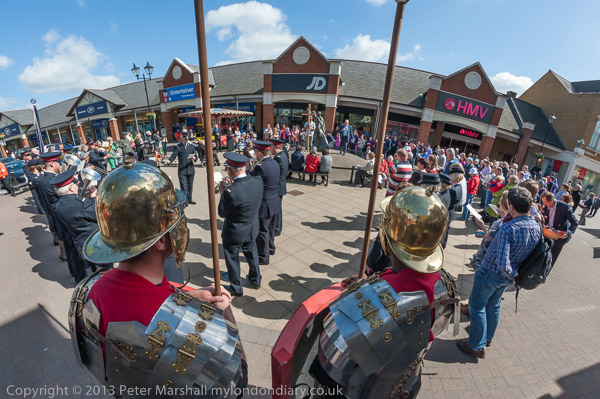
As usual the 16mm fisheye came in useful, both held way up above my head and a couple of Roman soldiers to give an overall view, and in the top picture on this post, where I think the perspective adds a little interest to the three women singing, although I think the Sally Army woman is a little worried that I was getting so close.
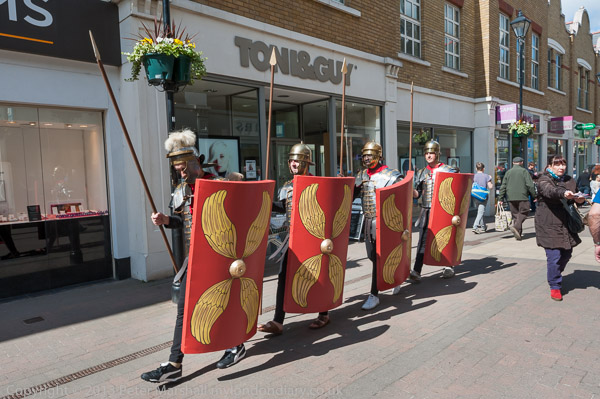
After the event had finished and all the hot cross buns were given out (and I had my second of the day) I waited around for the Roman soldiers to march back to the Methodist Church were they would be changing back into civvies and continuing their rehearsals for the following day’s Passion play.
I’d hoped to get a picture of them together with that sculpture of the men with the lino, and I did, but not a good one, as one of them suffered a severe wardrobe malfunction just before they reached it, with the strap on his shield becoming unstrapped. So although you can see a picture in Good Friday in Staines it only has two or the soldiers rather than the neat patrol of four I’d hoped for.
______________________________________________________
My London Diary : Buildings of London : River Lea/Lee Valley : London’s Industrial Heritage
All photographs on this and my other sites, unless otherwise stated, are taken by and copyright of Peter Marshall, and are available for reproduction or can be bought as prints.
To order prints or reproduce images
________________________________________________________